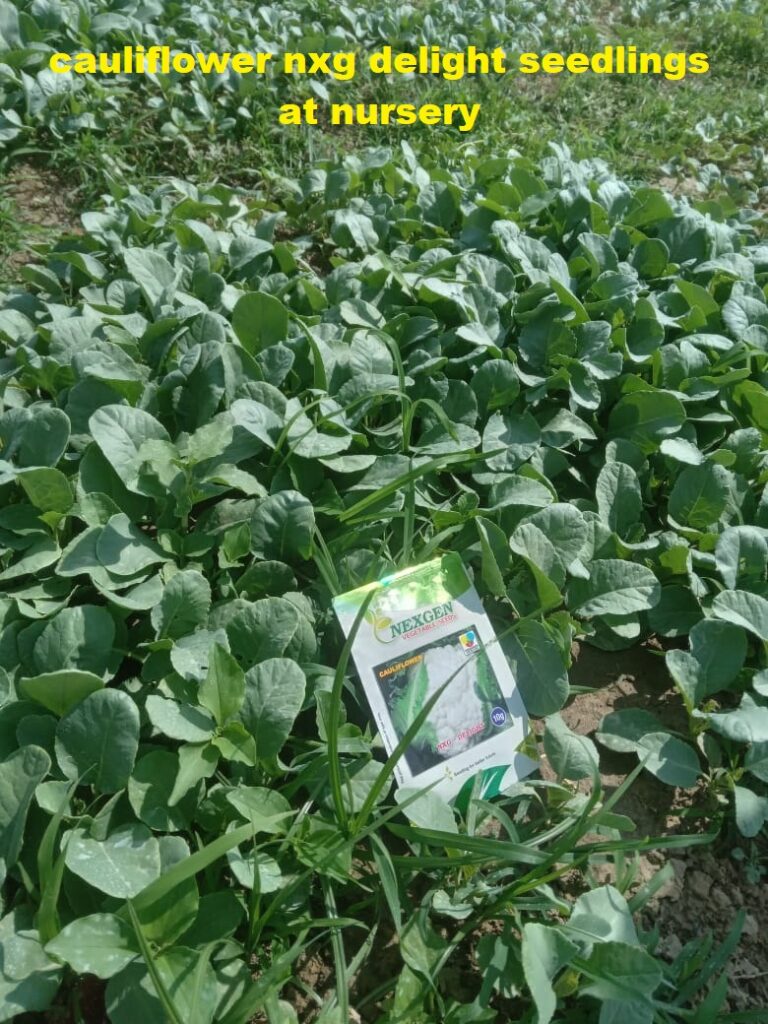Introduction:
Cauliflower, popularly known as “फूलगोभी” in Hindi, is a nutritious and versatile vegetable that holds immense potential for farmers and consumers alike. With its growing demand in domestic and international markets, it becomes crucial for the government to support and promote cauliflower farming. In order to enhance cauliflower cultivation and empower farmers, governments can introduce innovative schemes and initiatives. In this blog, we will explore some new government plans aimed at boosting cauliflower farming and its positive impact on the agricultural sector.

- Subsidized Seeds and Inputs:
One of the primary challenges faced by cauliflower farmers is the availability and affordability of quality seeds and agricultural inputs. To address this issue, the government can launch schemes that provide subsidized seeds, fertilizers, pesticides, and other essential inputs. By reducing the financial burden on farmers, these initiatives encourage increased cauliflower production and ensure better crop quality.
Read more: 25 Steps to Boost Cauliflower Production
- Technical Assistance and Training Programs:
In order to improve the overall productivity and efficiency of cauliflower farming, governments can establish training programs and provide technical assistance to farmers. These programs can include workshops, seminars, and field demonstrations on modern farming techniques, integrated pest management, crop rotation, and post-harvest practices. By equipping farmers with the necessary knowledge and skills, these initiatives enhance their ability to cultivate high-quality cauliflower crops.
- Irrigation and Water Management:
Cauliflower cultivation requires adequate water supply throughout the growing season. Governments can introduce schemes to improve irrigation infrastructure, such as the construction of canals, ponds, and wells, especially in regions prone to water scarcity. Additionally, promoting water-efficient practices like drip irrigation and rainwater harvesting can further optimize water usage and reduce production costs for farmers.
- Market Linkages and Post-Harvest Facilities:
To ensure fair prices and eliminate middlemen, governments can facilitate direct market linkages for cauliflower farmers. Establishing farmer-producer organizations and promoting farmers’ participation in agricultural markets can help them access better opportunities and negotiate favorable contracts. Moreover, the government can invest in post-harvest facilities like cold storage, processing units, and transportation infrastructure to minimize losses and extend the shelf life of cauliflower produce.
- Research and Development:
Investing in research and development (R&D) is crucial for the growth of the cauliflower farming sector. Governments can collaborate with agricultural universities and research institutions to conduct studies on disease-resistant varieties, nutrient management, and climate-resilient practices. These initiatives not only lead to the development of improved cauliflower varieties but also provide farmers with valuable insights to tackle emerging challenges.
Conclusion:
The government’s role in promoting and supporting cauliflower farming is vital for the overall growth of the agricultural sector. By introducing new initiatives such as subsidized seeds and inputs, technical training programs, improved irrigation facilities, market linkages, and R&D investments, governments can empower farmers and enhance cauliflower production. These measures will not only boost the income of farmers but also contribute to food security, rural development, and economic growth. It is crucial for policymakers to recognize the potential of cauliflower farming and prioritize the implementation of such initiatives to ensure a prosperous future for farmers and the nation as a whole.
- Financial Assistance and Insurance Schemes:
To mitigate the risks associated with cauliflower farming, governments can provide financial assistance and insurance schemes. This can include crop insurance programs that protect farmers against losses caused by natural disasters, pests, or diseases. Additionally, governments can offer low-interest loans and subsidies to farmers for purchasing equipment, machinery, and modern farming technologies. By providing financial support, governments enable farmers to invest in their cauliflower farms and adopt advanced agricultural practices, ultimately improving their yields and profitability.
- Organic Farming Promotion:
With the increasing demand for organic produce, governments can incentivize and promote organic cauliflower farming. This can be done by offering certification programs, technical guidance, and financial incentives to encourage farmers to adopt organic farming methods. Promoting organic cauliflower farming not only ensures healthier and chemical-free produce but also opens up new market opportunities and fetches premium prices for farmers.
Read more:- Top 15 Health Benefits of Cauliflower: Nutrition Powerhouse
- Awareness Campaigns and Consumer Education:
Governments can launch awareness campaigns and consumer education programs to highlight the nutritional benefits and versatility of cauliflower. By educating consumers about the various ways to incorporate cauliflower into their diets and promoting its health benefits, demand for cauliflower can be further increased. This would directly benefit cauliflower farmers by creating a sustained demand and better market prices.
- Export Promotion and Trade Facilitation:
To tap into international markets and boost cauliflower exports, governments can facilitate trade by simplifying export procedures, providing market intelligence, and negotiating favorable trade agreements. By promoting cauliflower as a high-quality agricultural product from their country, governments can create export opportunities for farmers, thus increasing their income and contributing to the overall economic growth of the nation.
- Monitoring and Evaluation:
Effective implementation of government initiatives requires proper monitoring and evaluation systems. Governments can establish mechanisms to track the progress and impact of the schemes introduced for cauliflower farming. This includes regular assessment of the adoption rates of new technologies, the economic well-being of farmers, and the overall growth of the cauliflower sector. Based on the findings, necessary adjustments and improvements can be made to ensure the effectiveness and sustainability of the initiatives.
Conclusion:
By implementing these new government initiatives, the cultivation of cauliflower can witness significant growth, benefiting farmers, consumers, and the agricultural sector as a whole. The government’s support in providing subsidized inputs, technical assistance, market linkages, irrigation infrastructure, research and development, financial assistance, and export promotion will create a conducive environment for cauliflower farmers to thrive. Through these collective efforts, cauliflower farming can become a lucrative and sustainable venture, contributing to food security, rural development, and economic prosperity.
- Collaboration with Agricultural Extension Services:
Governments can strengthen collaboration with agricultural extension services to ensure effective dissemination of knowledge and information to cauliflower farmers. Extension officers can work closely with farmers, providing on-ground support, guidance, and training on best agricultural practices. This collaboration can also facilitate the exchange of knowledge and experiences among farmers, fostering a sense of community and promoting continuous learning and improvement.
- Infrastructure Development:
Governments can invest in infrastructure development in cauliflower farming regions. This includes improving road connectivity to facilitate the transportation of cauliflower from farms to markets, establishing storage and processing facilities, and setting up farmer collection centers. These infrastructure developments streamline the supply chain, reduce post-harvest losses, and enable farmers to access better markets and higher returns for their produce.
- Promotion of Farmer Cooperatives:
Encouraging the formation of farmer cooperatives can empower cauliflower farmers and enhance their collective bargaining power. Governments can provide support and incentives to facilitate the establishment of cooperatives. These cooperatives can help farmers pool their resources, share knowledge, access credit facilities, negotiate fair prices, and collectively invest in value-addition activities. By promoting cooperation and collaboration, governments foster a more equitable and sustainable agriculture sector.
- Sustainable Agriculture Practices:
Promoting sustainable agriculture practices in cauliflower farming is crucial for long-term environmental and economic sustainability. Governments can encourage the adoption of organic farming methods, promote the use of biopesticides and biofertilizers, and raise awareness about soil and water conservation practices. By prioritizing sustainable agriculture, governments contribute to preserving natural resources, reducing chemical inputs, and ensuring the long-term viability of cauliflower farming.
- Market Diversification and Value Addition:
Governments can support cauliflower farmers in diversifying their market offerings and adding value to their produce. This can be achieved by promoting the development of processed cauliflower products such as frozen cauliflower florets, pickles, and dehydrated cauliflower. Governments can also facilitate market linkages with food processors, restaurants, and hotel chains to create demand for value-added cauliflower products. By adding value to their produce, farmers can increase their income and reduce dependency on volatile fresh produce markets.
- Research and Development for Pest and Disease Management:
Pests and diseases pose significant challenges to cauliflower farming. Governments can invest in research and development programs focused on developing pest-resistant varieties and effective disease management strategies. By collaborating with research institutions and providing financial support for such initiatives, governments contribute to minimizing crop losses, reducing the reliance on chemical pesticides, and ensuring sustainable cauliflower production.
Conclusion:
Through a comprehensive approach that encompasses support in terms of subsidies, training, infrastructure, market development, and sustainable practices, governments can create an enabling environment for the growth of cauliflower farming. By implementing these new initiatives, governments can empower cauliflower farmers, enhance productivity, and ensure a sustainable and profitable future for the sector. The success of these initiatives relies on effective implementation, regular monitoring, and continuous evaluation to address the evolving needs of cauliflower farmers and make necessary adjustments for long-term success.
Maximizing Yield with Cauliflower Seeds in India

